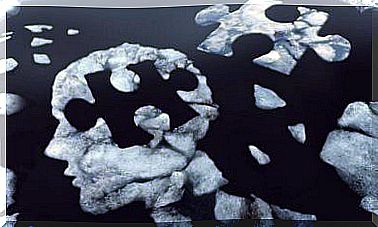The Neurobiology Of Intuition, Or The Gut Feeling

The neurobiology of intuition exists, and we have learned something very interesting about it. Most people base many of the decisions they make on their gut feeling. It is basically just an inner voice in contact with your identity and everything you have seen, felt and experienced. Your intuitive page can actually be a great tool if you know how to use it.
Let’s be honest. Intuition can often lead you to invisible universes, it can connect you to a part of yourself that is otherwise in the most hidden corners of your subconscious. It can feel so strange at times that you may not think it is a very scientific experience. It must be mysterious because there is no obvious logic behind it. But that is not entirely true.
The neurobiology of intuition
Intuition is often described as a sixth sense, and there is a lot of scientific literature on the subject. For example, we have fascinating books such as Educational Intuition by Robin M. Hogarth and Blink: The Art of Thinking Without Thinking (original title: Blink: The Power of Thinking Without Thinking) by Malcom Gladwell.
In these books and many others on the same topic, argue for the importance of intuition as a resource. They claim that it can actually complement analytical thinking.
Then we have researchers like Jonas Salk, who became famous in his time for inventing the polio vaccine. He wrote a thought-provoking book in 1983, called Anatomy of Reality: The Merging and Intuition and Reason . In it, he talked about how we should use our sixth sense in everyday life, because it can help us make better decisions.

What can the neurobiology of intuition tell us?
First of all, neurobiology suggests to intuition that these mental processes do not exist only in our imagination. They actually have a neurological basis. Dr. Keiji Tanaka from the RIKEN Brain Institute, led a fascinating study to try to find answers to what is happening in our brain to create this sixth sense.
To find out, he used expert-level shogis as his subjects. The game of shogi is very similar to chess, and the most skilled players use their intuition to make some fantastic moves. Dr. Tanaka also performed a series of MRI scans on the group to see which parts of the brain they used the most.
Praecneus (Isselapp)
According to the results of the scans, it was the praecneus area in the brain that lit up the most. This is a small part of the islet lobe (or parietal lobe) that also happens to be directly on the line between the right and left hemispheres of the brain.
The Praecneus area plays a role in episodic memory and visuospatial processes. But what is most interesting is that this area plays a role in consciousness.
Ventromedial prefrontal cortex
Another interesting area that lit up when using the intuitive parts of the brain was the ventromedial prefrontal cortex. This is an extremely important part of our brain. Why? This is where we store all the information about past rewards, along with the pain of mistakes, or things we wish we had not done, so that we would avoid having a negative experience.
The famous neurologist Antonio Damasio discovered how important this part of our brain is for the decision-making process. The most interesting thing about this brain structure is that its responses are based on emotions.
Here is an example: Imagine meeting someone at a party, who then invites you back to their apartment. The ventromedial pefrontal cortex will perform a rapid analysis based on past experience.
There may be something about their personality, how they look, or the way they speak that makes you skeptical of their suggestion. This is because they remind you of someone you had a negative experience with. From there, it will send out an alarm to get attention. It is intuition that tries to penetrate the consciousness.
Once you have heard the inner voice, you have two options. You can either listen to it, or send it through the filter for analytical thinking if you want to consider it further.

Basal ganglia (nucleus caudatus)
Scientific studies on the neurobiology of intuition have also emphasized the nucleus caudatus, part of what we call the basal ganglia, which plays an important role in learning, habit formation and automatic behavior.
The role of the nucleus caudatus in this process is to increase the speed of the sixth sense. It allows you to make faster, almost automatic decisions based on your past experiences or past learning.
As you can see, through all this information, it is difficult to call all these processes random, or a product of our imagination. Not only is it a neurological basis for intuition, but it also involves past experiences, our personality and subconscious, or the place that contains the essence of who we are.
Stomach feelings are not just pseudoscience. They are in fact a mechanism that has helped to define who we are as human beings across gender, race and culture. This is really worth thinking about. You should always listen to your inner voice, and use your ability to think analytically about situations when you need them.









